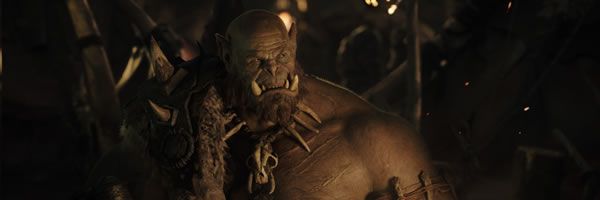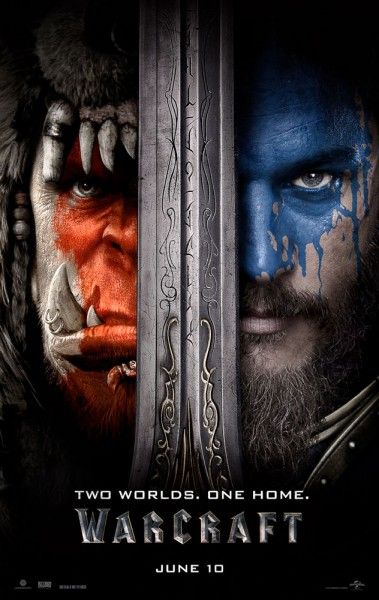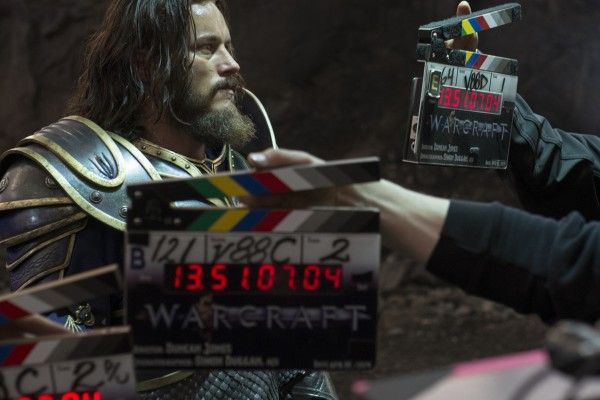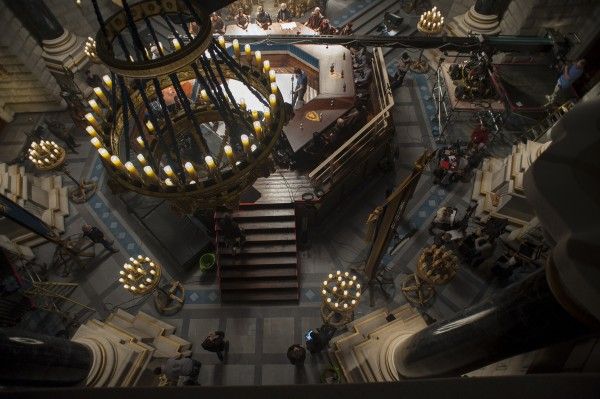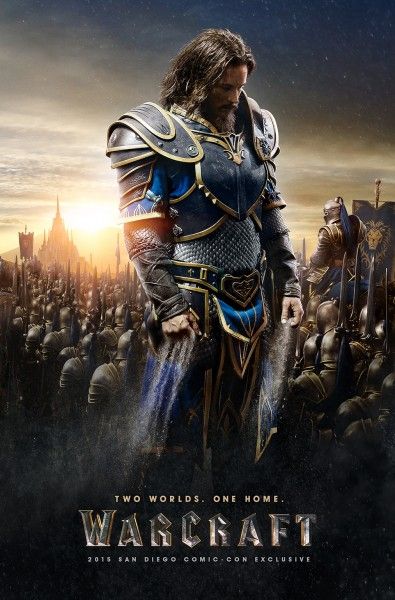Traditionally, video game movies are not good. History tells us they simply do not work. It’s kind of impressive, actually, how every single adaptation has failed to turn out a genuinely good movie. The closest we’ve come is Edge of Tomorrow, which feels like a video game adaptation but isn’t one. However, we just might be on the cusp of seeing the curse broken once and for all, and Universal Pictures, co-writer/director Duncan Jones, and producers Charles Roven, Thomas Tull, Jon Jashni, Alex Gartner and Stuart Fennegan are trying their darndest with Warcraft, a film that I was lucky enough to see being made in Vancouver last spring during a fascinating (and somewhat overwhelming) set visit.
A film adaptation of the immensely popular World of Warcraft has been in development for years. Sam Raimi was famously first attached and developed the project for a while, then Jones came in and finally brought this thing home with a unique spin on how to tell this particular story. And Universal isn’t skimping out on this gamble either. This is a massively realized project, complete with a giant ensemble cast, loads of gorgeously crafted costumes and sets, and cutting-edge motion-capture technology that bring the orcs to life in jaw-dropping detail. Oh yes, there are orcs.
The story crux of Warcraft is chronicling the battle between humans and orcs from both sides, as the orcs leave behind their dying home world and set about trying to colonize the human-filled Azeroth. Jones’ vision for the film was a movie in which both factions are given equal weight—there’s no “good side” and “bad side”. With the humans (or “Alliance”) we have Travis Fimmel (Vikings) as a knight who sacrificed everything to keep his kingdom safe, alongside Dominic Cooper’s King Llane and his wife Lady Taria (Ruth Negga) and Ben Foster as the mysterious mage Magus Medivh.
And on the orc side (or “Horde”) we have Dawn of the Planet of the Apes actor Toby Kebbell as Durotan, noble Chieftan of the exiled Frostwolf clan, Rob Kazinsky as his best friend Orgrim Doomhammer, Clancy Brown as fearsome chieftan Blackhand, Anna Galvin as Durotan’s wife, and Daniel Wu as the sinister orc warlock Gul’dan. Falling somewhere in between is half orc half human Garona, played by Paula Patton, who struggles to find her place in this world.
Last spring, I was invited along with a handful of journalists to visit the Vancouver set of Warcraft, which was about halfway through production at the time. It was clear from every department that Universal is putting a lot of resources into this film. It was also clear that Jones essentially had the creative freedom to make a large-scale fantasy epic that was quite possibly one of the nerdiest movies ever made. I’ll be honest, as someone only somewhat familiar with World of Warcraft, I had my reservations about the movie going in. However, I left the set feeling incredibly excited about what Jones and his team have put together—a complex, character-centric yet eye-popping fantasy epic told on a colossal scale—and I can’t wait to see it all fully realized when the film opens in theaters June 2016. Will it be the first good video game movie? I have reason to believe there’s a very good chance it might be.
While I’ll be sharing more from my set visit over the coming weeks, I wanted to offer readers a glimpse into what it was like to be on the set. Below, you can read my thorough set visit report, which includes details on the technology that was used to bring the orcs to life.
Technology
A cutting-edge team from ILM was put together to bring Warcraft to life through visual effects, specifically the orcs. Jones was adamant that the orcs needed to be realized in full CG in order to compete with other films like Dawn of the Planet of the Apes—the technology has reached a point to where audiences will follow a fully CG character throughout an entire movie, and the tech being used on Warcraft was the next level above what was done on Dawn.
In order to implement this on set, actors playing the orcs wore motion-capture suits opposite live-action performers. In the back of the set was something called a Brain Bar, which is where the tech team was set up to capture all of the digital information of the orc actors’ performances. Walking into the Brain Bar was like walking into a tent-sized NASA command center—there were computers everywhere.
The technology used on Warcraft allowed for those at the Brain Bar to see game-level renderings of the CG characters in real-time. So as the actors in motion-capture suits moved around the soundstage, you could see a very basic version of their CG counterpart on the monitor moving in step. The process was likened to that of directing a live show or a concert, with the VFX team constantly having to “put out fires” so to speak and fix issues on the fly. Because of the level of motion-capture used on the film and the sheer number of CG characters (the Brain Bar can handle up to 9 characters at once for a dialogue scene, and 4 or 5 for an action scene), Warcraft only had two days of on-location filming. The rest was done on soundstages with massive practical sets against blue screen. Speaking of which…
Filming
Once we arrived to the main, big stage, we caught a glimpse of what Jones and his team was filming that day. The scene in question took place on a battlefield of sorts, and indeed the entire stage had been outfitted with dirt, moss, and even a hill; the whole warehouse smelled like a genuine marsh. None of the principal actors were on set because the intricacies of the fight sequences necessitated stunt doubles, but we did see a group of humans charging towards a group of orcs (played by very tall, body builder-type men in performance capture suits), who were flanked by orc tents and cages that housed human prisoners. I won’t go into further details since it verges on spoiler territory, but I believe we were watching a sequence from the latter half of the film taking place a the orc camp set up near their portal.
Again, this stage was absolutely massive. It was possible to be on one end of the set and unable to see or hear what was going on at the other end. While the fact that a film as big as Warcraft had so little location shooting may be cause for pause on other movies, the sheer enormity of the soundstages being used meant that Jones and his team could outfit them with plenty of practical effects to compliment the CG backgrounds and environments.
Creating the World of Warcraft
While Warcraft is a CG-intensive film, our first stop on the set visit at the art department showed us how much care and detail went into the design of every single environment. Though Warcraft necessitates a fair amount of visual effects work to bring it to life, production designer Gavin Bocquet insisted on creating as many practical models as possible. Most of the sets have at least some practical element instead of shooting inside a wall-to-wall blue screen, and for both the physical and virtual elements of each set, Bocquet creates a detailed, miniature model. These models are used in a trial and error process, so the department can build out one idea, see what needs to be changed, and then build out another one.
The room housing most of the art department was absolutely filled with models. We saw orc tents, the Throne Room, full cities, and so much more. The models were created with an extreme attention to detail, and we were told that when Jones is filming a CG-heavy scene with his actors, he’ll bring the model of the set out to show them exactly where they are and what’s going on.
One of the most ambitious sets designed for Warcraft was Elywnn Forest. The team initially scouted to try and find an existing location, but none were a good fit. Instead, they scanned and created life-size trees that populated a 200 ft. x 100 ft. set with undulating topography. They would pump in mist and have horses riding through, and since the set was surrounded by blue screen, they could shoot from multiple angles in order to mimic the massive scale of the forest from the game. While we didn’t get to see Elwynn Forest (it had already been torn down), we did see a cliffside set that looked spectacular. Echoes of the Lord of the Rings franchise permeated many of the set designs that we saw, and that is a very good thing.
It was clear from our tour of the art department that this team very much had the gamers in mind. We were told that an homage to the game is included in every single set, and Blizzard would even create illustrations for them to use—specifically, the game design company created the chandelier that will be seen in the Throne Room.
We were also given a peek at a set that was in construction, the Energy Chamber. This was a huge, three-level set that would house a fight sequence with a character from the film and a CG-created Golem. The concept art we viewed showed a massive lightning storm in the middle of the room. For the Golem design, Jones actually discovered an illustration online done by an artist in Slovenia. They commissioned his drawings and used them as the template for the character in the film.
Conclusion
So my visit to the set of Warcraft was exhausting, but really that’s a good sign for the movie. There was an unbridled passion from everyone involved to make the best possible movie they could make, and from my point of view it didn’t feel like Universal was trying to “water down” the more fantasy-intensive aspects of the game. Quite the opposite, in fact—the film was being embraced as high fantasy, with the success of Game of Thrones no doubt bolstering Universal’s confidence.
Video game adaptations are indeed a tough nut to crack, but there’s so much story, mythology and lore in the World of Warcraft universe to be mined that it feels like this particular adaptation has a heavy leg up. Throw in an impeccably talented and enthusiastic filmmaker like Jones, a blend of gorgeously realized practical effects and insane next-level technology, and a solid ensemble cast, and you may just have the formula for the first good video game movie ever. We’ll find out for sure on June 10, 2016.
For more of my set visit coverage, peruse the links below.
- ‘Warcraft’: 35 Things to Know About Universal's Massively Ambitious Epic Fantasy
- ‘Warcraft’ Director Duncan Jones on Giant Weapons, Easter Eggs, and Hitting PG-13
- ‘Warcraft’: Rob Kazinsky Nerds Out on Playing an Orc, the Doomhammer, and Sequels
- New 'Warcraft' Images Feature Orcs, Humans, and Something in Between

